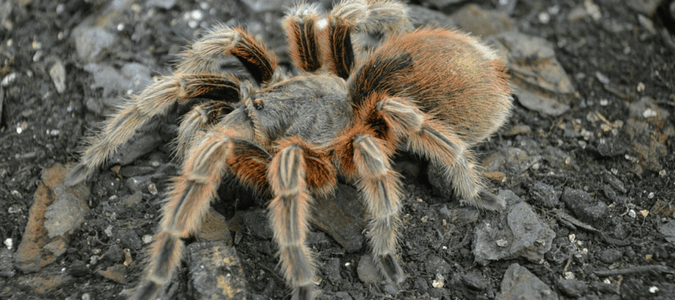
You and your family are still settling into your new home. There are boxes that need to be unpacked, but you need a break so you decide to walk around the property. It’s gorgeous out and you enjoy looking at the birds, pointing out butterflies and ladybugs, watching squirrels play. But then you see it: the largest spider you’ve ever come across and you realize, there are tarantulas in Texas. It seems as big as your hand and it looks terrifying.
Should you be worried? Will it hurt your kids? Are other tarantulas around? How do you keep them from getting in your house?
Should You Be Worried About Tarantulas in Texas?
First, let’s get something out of the way. Tarantulas are about as dangerous to people as bees are. In fact, that’s a really good comparison. If you’re bitten by a tarantula, it’s probably going to feel–and look–a lot like a bee sting. There will be pain, as well as some redness and swelling, but that’s about it.
Unless, of course, you’re allergic. In the same way that some people are allergic to bee stings, there are people who are allergic to the venom in a tarantula bite. If someone has trouble breathing or feels sick after a bite, call a doctor promptly. Even with this in mind, though, the danger is extremely minimal. As a tarantula expert noted for Texas Parks & Wildlife Magazine for a 2010 story, “To date, there has never been a proven human fatality directly resulting from the bite of a tarantula.”
In other words, for the most part, you don’t have to worry about tarantulas being dangerous for you or your family. Moreover, if you don’t make them feel threatened, they are more likely to try to run and hide than bite you.
Understanding Texas Tarantulas
Now that you know they can’t hurt you, let’s talk a bit more about tarantulas in Texas. Here is what you should know and what you can expect.
If you come across a tarantula in our state, it’s most likely going to be a Texas brown tarantula. They are not only one of the most common types of tarantulas in Texas, but in the southern United States as a whole, and chances are pretty good that you’ll stumble upon a few at one time or another. In adulthood, these spiders can have bodies 1 ½ inches in length and legs with a span over four inches. So not quite as big as your hand, but pretty big!
As the name implies, Texas brown tarantulas are, well, brown. More specifically, dark brown to black. And they have hair that covers most of their bodies. Just like other spiders, they have poisonous “fangs” on the ends of their chelicerae. When they bite prey, these “fangs” inject the victim with poison to make eating easier. Brown tarantulas typically live in burrows in grasslands and other semi-open areas that they often cover with a silk veil. They wait in these burrows until prey wander by, though sometimes they head out to forage close by.
Tarantulas mainly eat bugs, such as crickets, caterpillars, grasshoppers and different kinds of beetles. That being said, some of the biggest tarantulas will go after snakes, lizards, small rodents, small birds and even other tarantulas.
What to Do if you See a Texas Tarantula
If you do encounter a tarantula, the best thing to do is react calmly. Chances are, nothing will happen. Their only desire will be to get away and hide. If, however, the tarantula feels disturbed, they may act in a defensive manner.
This involves turning to face you, raising up on their hind legs and spreading their front legs wide to seem bigger and more threatening. You may even see them brush their abdomen with their legs. They do this to dislodge hair because it can irritate the skin or eyes of an attacking creature.
ABC Are Your Pest Experts
Even though tarantulas aren’t particularly dangerous to people or (most) pets, that doesn’t mean you want to live with them. So if you’re worried about tarantulas in your yard, any other type of spiders or how to keep pests out of your house, get in touch with your local pest control specialist at ABC Home & Commercial Services and technicians can handle even the toughest pest problem.
